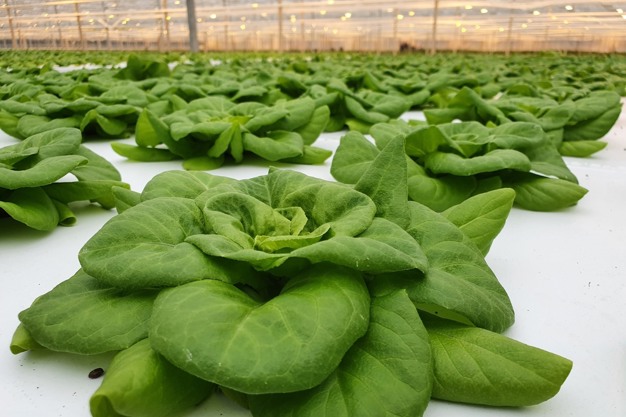Automation is a great solution for growing lettuce and herbs, and it saves on labor. But how do you automate ponds that are full of water with floating trays? And how do you then keep the water quality in order? Or: how to grow multiple types of crops at multiple densities on an automatic mobile gutter system (MGS)? KG has found something to that. Over the past five years, they have done a development where it is possible to grow lettuce, herbs, and baby crops on a mobile growing table system, without having to leave water sloshing over it or interfering with the electronics. Matthias Haakman of KG tells us more about this interesting concept.

Space for the roots
"At the bottoms of the growing tables, we made a support for the trays. This way, the tray does not lie directly on the bottom, but there is space in between. If you then put water in and it drains away, the moisture remains underneath, without the roots drying out. Because there is space in between, the roots do get room to absorb oxygen. The design of the trays and bottoms is so well matched that we see a big increase in production per square meter as a result."

Automating from propagation to harvest
As already mentioned in the introduction, the new system also contributes to better automation. "Filling and seeding a seed tray can already be done fully automatically now. We can automatically place that seed tray in the next line in a table to send to a germination cell and then to a propagation cell or to the greenhouse."
After 1-2 weeks, the table is taken back out of the greenhouse or cell to the workspace for transplants. "This can be done by hand, but also automatically. Then we transplant it from the sowing tray to the propagation tray. Then it goes back into the greenhouse - depending on the crop, the table can be taken back to the workroom after some time. Then we can harvest and clean it completely automatically, ready for the next round."

Hybrid solution
That sounds like a great solution. Matthias explains that it is a kind of "missing puzzle piece". "It is a hybrid solution between two solutions that are already there. In lettuce and herb growing, there are two systems on the market now. You have floats on ponds - that system is very difficult to automate. And you have a 30-cm layer of water, which is never changed in its entirety. The water quality is then difficult to control, and you have problems with oxygen levels and disease pressure."
The other system is the mobile flume system. "That's quite an expensive system - there's a lot of automation in it, and it's often under the system making it difficult to access. It's also not very flexible: there are all these holes in it at a certain distance. Suppose you then want to change to a crop with a different density - that becomes difficult. Then it costs you production, or the plant has too little space to grow properly."

Economic impact
Apart from the advantages of cultivation, there are also economic benefits to the system, Matthias explains. "Because it is a hybrid system between a pond and gutter system, it also falls between the two in terms of investment - but it has the advantages of both systems, without the disadvantages. For crops like baby lettuce, it is very interesting because it is flexible and you can fully automate it."
Finally, a word on yield per square meter. "The system can be built in different ways. It can be all manual, single-layer - then you get a very interesting system in terms of cost, with all the advantages, but a low investment. Then you have the same output as a pond, which is lower than from a mobile gutter system though," Matthias explains.
"We can, however, automate further and do propagation and germination in a multi-layer setup: i.e. propagation in a vertical farm and outgrowth in a greenhouse. In doing so, we have seen yields 20-25% higher than in a mobile gutter system, for a similar investment. I also already have a business case before me in which the investment is recouped within one and a half years, and where yields as high as 125 kg per m² per year are possible."

New, yet not new
This all sounds futuristic, but it is not new. "We used existing techniques that were already available, this allowed us to skip a lot of teething problems. We collaborated with growers, and leading suppliers of trays, substrates, and seeds, among other things. We refined the existing techniques until we were satisfied with the system as it is now. There are now several parties in the market that have adopted the system, the early adopters. We have learned a lot with/from these together, and now the system is ready for the big market. We see many opportunities, especially in markets like North America, where small lettuce varieties are booming."
For more information:
Matthias Haakman  KG Systems
KG Systems
Tel: +31 (0)61546 4740
matthias@keesgreeve.nl
www.kgsystems.nl
